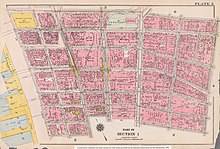
The IRT Ninth Avenue Line, often called the Ninth Avenue Elevated or Ninth Avenue El, was the first elevated railway in New York City. It opened in July 1868 as the West Side and Yonkers Patent Railway, as an experimental single-track cable-powered elevated railway from Battery Place, at the south end of Manhattan Island, northward up Greenwich Street to Cortlandt Street. By 1879 the line was extended to the Harlem River at 155th Street. It was electrified and taken over by the Interborough Rapid Transit Company in 1903.
The IRT Lexington Avenue Line is one of the lines of the A Division of the New York City Subway, stretching from Lower Manhattan north to 125th Street in East Harlem. The line is served by the 4, 5, 6, and <6> trains.
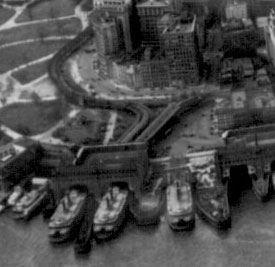
The South Ferry station was an elevated station at the southern terminal of the IRT Second, Third, Sixth and Ninth Avenue Lines. It was located next to Battery Park at the lower tip of Manhattan, New York City. Two tracks came from the combined Second and Third Avenue Lines, and two from the Sixth and Ninth Avenue Lines, making four tracks at the terminal, with platforms on the outside and between each pair of tracks.
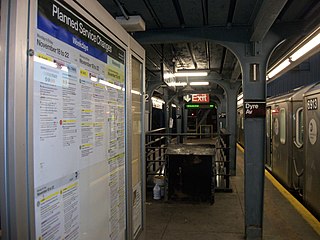
The Eastchester–Dyre Avenue station is the northern terminal station of the IRT Dyre Avenue Line of the New York City Subway, at Dyre Avenue and Light Street in the Eastchester neighborhood of the Bronx. It is served by the 5 train at all times.
The Battery Place station was a station on the demolished Ninth Avenue and Sixth Avenue elevated train lines in Manhattan, New York City. It was located at the southern terminus of Greenwich Street at the north end of Battery Park.
The Rector Street station was a station on the demolished IRT Ninth Avenue Line in Manhattan, New York City. It was built in 1874, and had two tracks and two side platforms, though two additional tracks ended at a bumper just south of the station. It was served by trains from the IRT Ninth Avenue Line, and was one block west of Rector Street El Station on the IRT Sixth Avenue Line. In 1918, the IRT extended what is today known as the Broadway–Seventh Avenue Line from Times Square down to South Ferry and built their own Rector Street station as one of the stations, serving as competition for the Ninth Avenue Line station. The el station closed on June 11, 1940. The next southbound stop was Battery Place. The next northbound stop was Cortlandt Street for Ninth Avenue Line trains.
The Warren Street station was an express station on the demolished IRT Ninth Avenue Line in Manhattan, New York City. It had three tracks, one island platform and two side platforms. It was served by trains from the IRT Ninth Avenue Line. It opened on February 14, 1870 and closed on June 11, 1940. The next southbound local stop was Barclay Street. The next southbound express stop was Cortlandt Street. The next northbound local stop was Franklin Street. The next northbound express stop was Desbrosses Street.
The Franklin Street station was a local station on the demolished IRT Ninth Avenue Line in Manhattan, New York City. It had three tracks and two side platforms. It was served by trains from the IRT Ninth Avenue Line. It opened on January 21, 1873, and closed on June 11, 1940. The next southbound stop was Warren Street. The next northbound stop was Desbrosses Street.
The Desbrosses Street station was an express station on the demolished IRT Ninth Avenue Line in Manhattan, New York City. It had three tracks, one island platform and two side platforms. It was served by trains from the IRT Ninth Avenue Line. It opened on November 23, 1873 and closed on June 11, 1940. The next southbound stop was Franklin Street, while the next southbound express stop was Warren Street. The next northbound stop was Houston Street, while the next northbound express stop was Christopher Street. The station was located one block east of the Desbrosses Street Ferry's slip which provided connections to the railroad terminals in at Exchange Place and Pavonia.
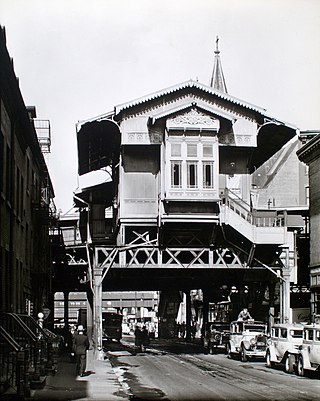
The Christopher Street station was an express station on the demolished IRT Ninth Avenue Line in Manhattan in New York City. It had three tracks, one island platform and two side platforms. It was served by trains from the IRT Ninth Avenue Line. It opened on November 3, 1873 and closed on June 11, 1940. On February 25, 1908, the Hudson and Manhattan Railroad built a subway station just east of this station as part of the extension between Hoboken and 33rd Street. The next southbound local stop was Houston Street. The next southbound express stop was Desbrosses Street. The next northbound stop was 14th Street for all trains.
The 14th Street station was an express station on the demolished IRT Ninth Avenue Line in Manhattan, New York City. It had two levels. The lower level was built first and had two tracks and two side platforms. The upper level was built as part of the Dual Contracts and had one track and two side platforms over the lower level local tracks. It closed on June 11, 1940. The next southbound stop was Christopher Street for express and local trains. The next northbound local stop was 23rd Street. The next northbound express stop was 34th Street.
The 66th Street station was an express station on the demolished IRT Ninth Avenue Line in Manhattan, New York City. It had two levels. The lower level was built first and had two tracks and two side platforms. The upper level was built as part of the Dual Contracts and had one track and two side platforms over the lower level local tracks. The station closed on June 11, 1940. The next southbound local stop was 59th Street. The next southbound express stop was 34th Street for Ninth Avenue trains, and 50th Street for IRT Sixth Avenue Line express trains. The next northbound local stop was 72nd Street. The next northbound express stop was 116th Street. The express run from this stop to 116th Street was the longest express segment out of all New York City elevated lines, bypassing seven local stations.

The 42nd Street station was a local station on the demolished IRT Ninth Avenue Line in Manhattan, New York City. It was opened on November 6, 1875, and had two levels. On the lower level, the local trains stopped, on two tracks serving two side platforms. The upper level was built as part of the Dual Contracts and had one track which carried express trains bypassing the station. The next northbound stop was 50th Street. The next southbound stop was 34th Street. The station was closed on June 11, 1940.
The 59th Street station was a local station on the demolished IRT Ninth Avenue Line in Manhattan, New York City. It had two levels. The lower level was built first and had two tracks and two side platforms that served local trains. The upper level was built as part of the Dual Contracts and had one track that served express trains. It closed on June 11, 1940. The next southbound stop was 50th Street for Ninth Avenue trains and Eighth Avenue for IRT Sixth Avenue Line trains. The next northbound stop was 66th Street.
The 86th Street station was a local station on the demolished IRT Ninth Avenue Line in Manhattan, New York City. It had two levels. The lower level was built first and had two tracks and two side platforms and served local trains. The upper level was built as part of the Dual Contracts and had one track that served express trains that bypassed this station. It opened on June 21, 1879 and closed on June 11, 1940. The next southbound stop was 81st Street. The next northbound stop was 93rd Street.
The 104th Street station was a local station on the demolished IRT Ninth Avenue Line in Manhattan, New York City. It had two levels. The lower level was built first and had two tracks and two side platforms and served local trains. The upper level was built as part of the Dual Contracts and had one track that served express trains that bypassed this station. It opened on June 21, 1879, and closed on June 11, 1940. The next southbound stop was 99th Street. The next northbound stop was 116th Street station until June 3, 1903, and then 110th Street. This had a view of the Suicide Curve at 110th Street.
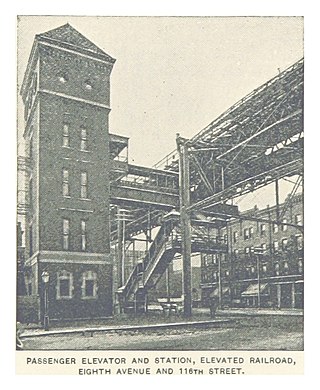
The 116th Street station was an express station on the demolished IRT Ninth Avenue Line in Manhattan, New York City. It had three tracks and two island platforms. It opened on September 17, 1879, and closed on June 11, 1940. The next southbound local stop was 104th Street station until June 3, 1903, and then 110th Street. The next southbound express stop was 66th Street. The next northbound stop was 125th Street for all trains. The express run from this stop to 66th Street was the longest express segment out of all New York City elevated lines, bypassing seven local stations.
The 125th Street station was an express station on the demolished IRT Ninth Avenue Line in Manhattan, New York City. It had three tracks and two island platforms. It opened on September 17, 1879, and closed on June 11, 1940. The next southbound stop was 116th Street for all trains. The next northbound local stop was 130th Street. The next northbound express stop was 145th Street.
The 50th Street station was a station on the demolished IRT Sixth Avenue Line in Manhattan, New York City. It had two tracks and two side platforms. It was served by trains from the IRT Sixth Avenue Line and opened on June 5, 1878. It closed on December 4, 1938. The next southbound stop was 42nd Street. For some trains, the next northbound stop was 58th Street Terminal until 1924, while for other trains, the next northbound stop was Eighth Avenue. For express trains, the next northbound stop was 66th Street on Ninth Avenue. Two years later after the station closed, it was replaced by the nearby underground 47th–50th Streets–Rockefeller Center subway station.

